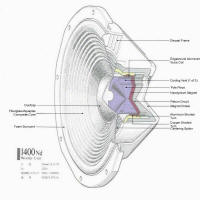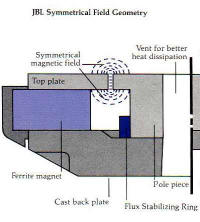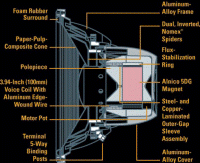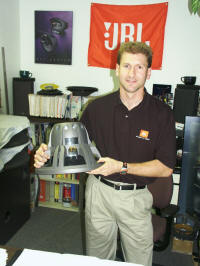|
Development of the 1500AL traces back to the first K2 low frequency
driver, the 1400Nd. That driver was originally developed in 1989 for the
K2-S9500 by Doug Button, currently Vice President of Research and
Development at JBL Professional. The intent was to go ”“all out” in the
design of a linear, low distortion, high output driver. From Doug's
perspective, there was only one way to achieve the lowest possible
distortion – an underhung design. Underhung designs use a voice coil that
is considerably shorter than the magnetic gap in which it is suspended.
Most dynamic loudspeakers use a voice coil that extends well above and
below the magnetic gap to make the most use of the magnetic energy.
However, there is a price in increased distortion. It has to do with the
fact that the coil is not acted upon symmetrically by the permanent field
once it is displaced from the rest position. Conversely, in an underhung
design, the full coil is always immersed in a constant strength magnetic
field since it never leaves the gap.
|

Doug Button
© Don McRitchie
|
Underhung designs are
not common in dynamic loudspeakers due to their cost. The fact that the
coil height is less than the gap height means that there are always
portions of the permanent field that are not in contact with the coil.
This is wasted magnetic energy and requires an inordinately strong magnet
to ensure reasonable sensitivity. To gain the necessary magnetic flux
levels, Doug specified the very first use of neodymium magnets for low
frequency transducers. Neodymium magnets have approximately 10 times the
magnetic energy by weight as ferrite magnets. Their use resulted in a
relatively compact driver that was exceptionally free from distortion, yet
had high sensitivity and high output.
|

1400Nd
© Harman International
,
Courtesy Greg Timbers
|
The 1400Nd driver, and
subsequent K2 systems that employed it, were a stunning success. However,
Doug was not completely satisfied. Classic underhung designs have a unique
frequency response anomaly that is due to the coil topology. It regards
eddy currents set up by the moving coil in the gap. These currents act as
the secondary in a transformer to effectively short out the coil circuit
leading to a loss in voltage drive. The net result is a ”“swayback”
response curve through the midband with about a 2db drop in output. While
this can be dealt with in network compensation, the purist in Doug wanted
that energy back. Addressing this would be the starting point for the
1500AL design.
Design work for the
K2-S9800 and its transducers began in 1999. The focal point of this system
was to be an Alnico magnet woofer with an underhung coil. Alnico had been
the magnetic material of choice for JBL from its very inception until the
late 1970's. In 1978, a civil war in Zaire resulted in the temporary
embargo of the commercial supply of cobalt that was a primary ingredient
in Alnico. Over a one year period, virtually every loudspeaker
manufacturer was forced to switch to more readily available ferrite
magnets.
|

SFG Magnet Structure
© Harman International
,
Courtesy Mark Gander and John Eargle
|
Initially, this
magnetic material presented problems compared to Alnico. It was less
powerful by weight, requiring much more magnetic material than an
equivalent Alnico. It was more susceptible to flux modulation caused by
voice coil currents and more susceptible to flux loss due to heating. None
of these constraints were absolute. Through innovative engineering (eg.
SFG, VGC and SVG motors), JBL was able to develop ferrite magnet drivers
that exceeded the performance of the previous Alnico versions.
Nonetheless, the
ferrite developments led to an interesting question. What would happen if
the same level of innovation applied to ferrite designs were applied to
Alnico motors? As described above, Alnico starts off with a number of
intrinsic advantages compared to other magnetic materials. By leveraging
these advantages, it should be possible to achieve new levels of accuracy.
This became the design
goal for the 1500AL. The intent was to end up with a bass driver with the
lowest distortion possible while retaining the efficiency and dynamic
response that were the hallmarks of JBL. However, there was one major
disadvantage in Alnico loudspeakers that would have to be addressed – the
susceptibility to permanent demagnetization due to overpowering.
This phenomenon is a
result of variability in strength of the permanent magnetic field caused
by interference from the voice coil's electromagnetic field. This is
referred to as flux modulation and is a leading cause of distortion in any
dynamic loudspeaker. The electromagnetic field generated in the coil
pushes against the global magnetic field set up by the permanent magnet
and return circuit, causing it to ”“bend”. Under normal operating
conditions, Alnico magnets actually resist this bending better than most
other magnet materials. However, should this shift become large enough, it
will exceed the coercivity of Alnico and cause it to partially
demagnetize.
JBL had done extensive
work in stabilizing flux modulation during the conversion to ferrite
magnet motors. Ferrite is much more susceptible to flux modulation than
Alnico. The coercivity is much higher so that extreme modulation will not
result in demagnetization. However, under normal operating conditions,
this flux modulation will manifest itself as second order harmonic
distortion. By installing a copper shorting ring around the base of the
pole piece, JBL engineers were able to reduce flux modulation, and
therefore distortion levels in ferrite motors, to very low levels.
Doug Button realized
that this same technology could be extended to control flux modulation to
such a degree that the coercivity in an Alnico magnet would never be
exceeded. He specified a huge copper shorting ring that would buck any
changes in the global field that was induced by the voice coil signal. The
result was that the major drawback of using Alnico for a loudspeaker
magnet had been completely eliminated.
Nonetheless, Doug was
not done in setting the design parameters for the 1500AL. There remained
the previously identified issue of midband loss in output and a more
subtle form of flux modulation that was not addressed with the large
shorting ring. Doug would devise an ingenious solution that would resolve
both of these issues – a lamination of copper and steel rings applied to
the outside diameter of the voice coil gap.
Before detailing this
solution, it is worthwhile understanding the phenomenon of ”“local” flux
modulation. The variability in the overall strength of the permanent
magnetic field is referred to as ”“global” flux modulation and this was
controlled through a massive shorting ring. However local variance in the
flux field was determined to exist in the voice coil gap, independent of
variance in the global field. It was particularly an issue for an
underhung design like the 1500AL which had an inordinately deep gap. The
AC field generated by the voice coil would cause variance in the gap
strength from top to bottom that dynamically resulted in a teeter
tottering effect. Doug realized that another copper shorting ring placed
in the gap would address this phenomenon. However, it came to him as an
inspiration, that by interspersing steel coils in between a series of
copper coils, he could break up the eddy currents that were causing the
midband loss. Thus, came the specification for a series of laminated coils
of alternating copper and steel construction that would be applied to the
outside diameter of the coil gap.
|

1500AL Cross-Section
© Harman International
|
With this final
attribute, the conceptual design for the 1500AL was set. However, there
was now the formidable task of developing the concept into a production
driver. Responsibility for this would fall upon Jerry Moro, Senior
Transducer Engineer for JBL Consumer Products. Jerry recognized that for
the dynamic range requirement of modern digital sources, the driver would
have to accommodate large excursions. A large coil would be required, but
to maintain the underhung topology, there would need to be a gap depth of
unprecedented proportions. Ultimately, a 0.8” long coil would be suspended
in a 1.5” deep gap. This would accommodate 1” of peak to peak excursion.
The magnetic energy requirements to provide a reasonable flux density in
such a deep gap was enormous. It resulted in an Alnico magnet of massive
proportions. An Alnico slug weighing over 5lbs became the core of the
motor structure. The overall structure would weigh over 30lbs.
The large excursion
requirements presented unique suspension demands. Normally, the surround
and spider are designed to act together to provide restoring force and
damping for the cone movement. However, with these large excursions, the
different construction of the surround and spider would result in non
symmetric response to deflections and therefore distortion. Jerry
addressed this by designing a mirror imaged pair of spiders that acted
symmetrically and thus allowed the surround to be optimized for linearity.
Mirror imaging the spiders resulted in any distortion components being
cancelled out.
|

Jerry Moro with1500AL
© Don McRitchie
|
A major focus of
Jerry's design for the 1500AL was to minimize power compression. Power
compression regards a reduction in output as power levels increase. It is
the biggest factor in restricting dynamic response. Therefore, mitigating
it to the maximum degree became a design objective. Heat is by far the
major culprit behind dynamic compression. It causes energy losses in the
permanent magnetic field and impedance changes in the coil that conspire
to reduce output as heat builds up. Jerry designed a series of measures to
dissipate heat.
First, the pole piece
and magnet have three channels embedded along their outer circumference.
Air trapped behind the dustcap is forced past the coil and out these
channels to convectively cool the coil. Next, an aluminum motor cap
completely surrounds the magnetic return structure. A series of ribs draws
heat away from the iron pot to the cap which acts as a large heat sink.
Finally, there is an air gap between the cap and the pot structure that is
vented in the rear. The motion of the spiders pumps air into this gap to
provide further convective cooling.
The net result is a
woofer that arguably has lower levels of power compression than any other
loudspeaker of its size. It can sustain maximum output levels of 118db
with minimal distortion. Testing at a 110db output level revealed midband
distortion to be down 50db, or around 0.3%. In summary, the 1500AL sets an
unprecedented standard for accuracy, dynamic response and freedom from
distortion.
© 2004 Don McRitchie
based on information provided
by Doug Button and Jerry Moro
|